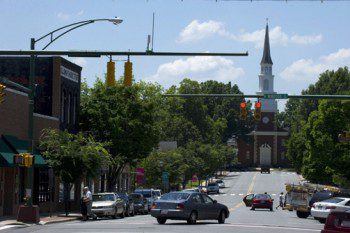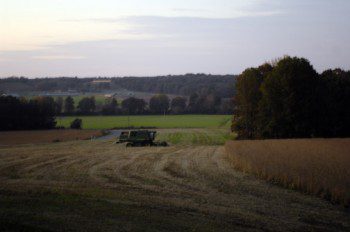Union County: An Introduction

Introduction: More than any other county in the Charlotte region, Union represents the dramatic suburban growth that has transformed rural areas surrounding Mecklenburg into sprawling residential “bedroom communities”. Union’s growth over the past few decades has been staggering. US Census estimates since 2000 have consistently listed Union not only as North Carolina’s fastest growing county, but among the fastest growing in the United States as well. This growth took place in a relatively short period of time, and across an agricultural landscape in western Union that had little in the way of established urban areas, or the infrastructure necessary to support them, beforehand. Therefore, much of Union’s growth has taken the form of the low-density residential and commercial development characteristic of American suburbs of the past twenty years. The recent economic recession and its impact on the housing industry in particular have, for the first time in a decade, cooled Union’s rapid growth. Once the economy turns around, however, observers will be watching closely to see if Union County picks up where it left off, or if this brief respite has caused some local communities to reassess their attitudes toward growth in substantive ways.
Historical Overview: An excerpt from A Guide to the Historic Architecture of Piedmont North Carolina (UNC Press) Catherine Bishir and Michael T. Southern (p. 502-506)
“Formed in 1842 from Anson and Mecklenburg, the county was named Union to resolve a dispute between Whig and Democrat factions who wanted Clay or Jackson. Like neighboring counties, it was settled by Scotch-Irish and other largely self-sufficient farmers, with cotton gaining importance in the 19th c. Links with neighboring South Carolina were strong. Several houses have porches with the pillars freestanding in the front of the porch floor, a feature seen in N.C. chiefly along the South Carolina border.
Economic troubles after the Civil War, coupled with the arrival of railroads – the Central Carolina (CCRR) in 1874 from Wilmington to Charlotte and the Georgia, Carolina & Northern (GC&N), 1888-92 – increased reliance on cotton and on the crop-lien and tenant systems. Many farmers, however, thrived sufficiently to build unusually stylish farmhouses in the late 19th and early 20th centuries. Little railroad towns sprang up, and the county seat of Monroe flourished into a cotton market and manufacturing town. In the late 20th c., as farming diminished, the eastern section of the county remained relatively rural, while the west saw rapid suburbanization from Charlotte.”
Union Today: Despite its status as North Carolina’s fastest growing county over the past decade, Union remains a difficult county to stereotype. While the western part of the county is recognized for its suburban development, the rest of the county remains solidly rural. Fueled by the poultry industry, Union even ranks third in the state in agricultural income, an amazing fact considering that over the past two decades the county converted an average of ten acres a day from open space to developed uses, according to a recent UNC Charlotte study. Situated in the middle of these two very different environments is the county seat of Monroe, which despite the changes that have transformed communities in the western part of the county, has remained relatively unchanged from the medium-sized town that it was in 1990. Compared to regional peers such as Concord in Cabarrus County and Rock Hill in York County, Monroe has been less affected by the county’s overall growth than one might expect.
Western Union County’s growth can be attributed primarily to two factors: its proximity to booming southeast Charlotte, and low residential property taxes. Looking at the usual drivers of growth in metropolitan areas – infrastructure – Union is not very well served. No interstate or limited access highway connects Union to Charlotte, and the county’s only major multi-lane highway, US 74, has a reputation for congestion; so easy access to Charlotte has never been a convincing argument for Union in recruiting new businesses, certainly not in the same way that it has for counties like Iredell, Cabarrus and York. Similarly, Union’s water & sewer capacity is limited, relying heavily on private wells, septic tanks and developer-financed “package plants” to fill in the gaps where county and municipal systems do not offer service. Yet, in spite of these infrastructure challenges, Union’s growth (primarily residential) has continued at an extraordinary pace, the result of the county being located in the direct path of the sprawling development expanding outward from southeast Mecklenburg’s affluent subdivisions – development that, once it crossed the county line, found in the lower property taxes of western Union’s municipalities the sort of fertile ground that only accelerated growth.
As the recent economic recession has exposed fundamental weaknesses in America’s housing industry, questions have surfaced about the sustainability of local economies built almost exclusively on residential development. Even before the Great Recession, Union’ leaders were already recognizing the dangers of a local economy and tax base so dependent on residential growth. Union enacted one of the region’s few Adequate Public Facilities Ordinances to help pay for new school construction to serve the county’s booming residential population, while several major economic development strategies were given top priority status. The planned Monroe Connector/Bypass, for one, is intended to give Union the improved access to Charlotte and Interstate 485 that the existing US Highway 74 corridor, with all its congestion, has been unable to provide. And one of the county’s main economic development agencies, the Union Partnership for Progress, has launched an ambitious effort to establish a premier business park, called Project Legacy, on 5,000 acres in the eastern part of the county.
Even if such efforts at economic diversification are successful, larger questions have surfaced about the sustainability of western Union County’s prevailing pattern of residential development. Most analysts expect the county’s residential growth to continue once the economy recovers, perhaps at a somewhat slower pace. However, in places like Mineral Springs and Wesley Chapel, local residents – many of them newcomers – are beginning to question Union’s long-established pattern of low-density development. Some have even raised the prospect of new land use ordinances to encourage more compact, pedestrian-friendly developments that create a greater sense of place. Other residents have begun to question whether Union can sustain its residential growth without greater water & sewer capacity, acknowledging that there are challenges in building such capacity due to the proliferation of new municipalities in the county with different priorities and attitudes toward revenue generation. How these new ways of thinking about development play out in a county that has traditionally embraced unbridled residential growth will be one of the more interesting stories to follow in the years ahead.

Today, as the county reassesses its role within the Charlotte region and finds itself in a post-recession era where both the rules and the playing field for the residential real estate market have changed dramatically, new conflicts are likely to surface reflecting different philosophies about Union’s future. Agricultural interests in the eastern part of the county will likely be more forceful in trying to hold on to their rural way of life, while established development interests in the western part of the county will continue to look for new opportunities to expand residential growth. And added to this mix will be a new set of voices, made up of residents who moved to the county fairly recently to live in all those new subdivisions, but, having set down roots in the county, are now starting to demand more control over land use issues affecting their quality of life. As these conflicts come to the surface in the years ahead, residents should not see them as a sign of dissolution, but as a natural and healthy part of Union’s evolution as a county. — Jeff Michael
Photos by Nancy Pierce
Union County links
Union County Articles & Publications







